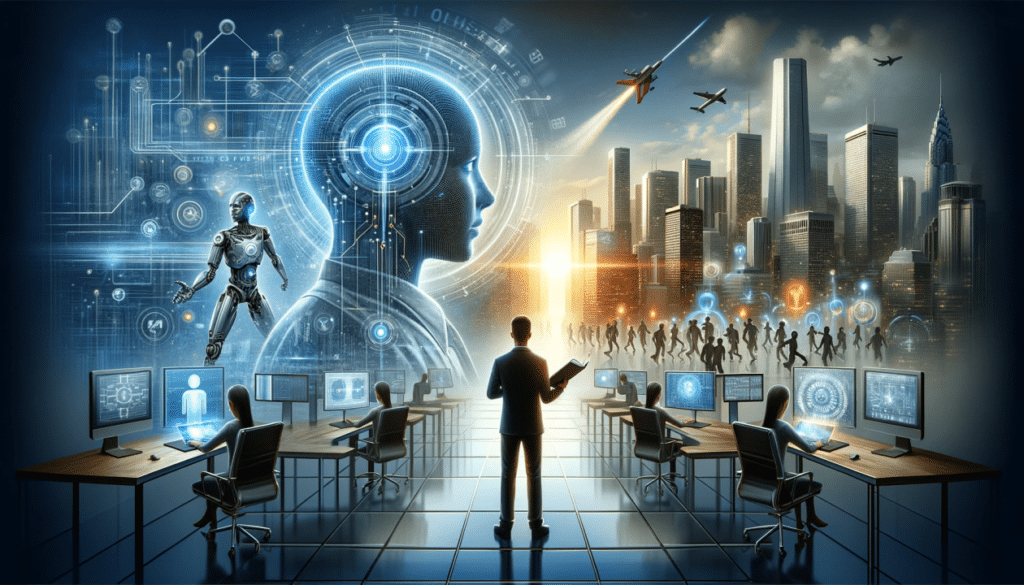The intersection of technology and employment has always been a dynamic space, but the pace and scale of change in recent years are unprecedented. Future technologies, particularly automation, artificial intelligence (AI), robotics, and machine learning, are set to transform the U.S. job market in ways that were unimaginable just a few decades ago. The implications of these advancements are profound, as they will not only redefine existing roles but also create new ones, alter the nature of work itself, and challenge the traditional concepts of employment. In this article, we explore how future tech will impact U.S. jobs, the opportunities and challenges it presents, and how workers and businesses can adapt to this rapidly evolving landscape.
The Transformative Power of Automation and AI
Automation and AI: The Current Landscape
Automation and AI are no longer futuristic concepts; they are already deeply embedded in many aspects of our daily lives and industries. Automation, which involves the use of technology to perform tasks with minimal human intervention, is most visible in manufacturing and logistics. In warehouses across the country, robots and automated systems are taking over tasks that were once performed by human workers. These systems can work around the clock without fatigue, increasing efficiency and reducing costs for businesses.
AI, on the other hand, involves machines that can learn from data, make decisions, and perform tasks that traditionally required human intelligence. AI is being applied in various industries, from healthcare to finance, where it is used to analyze large datasets, identify patterns, and make predictions. For example, in the healthcare sector, AI algorithms can analyze medical images to detect diseases more accurately than human doctors in some cases. In finance, AI is used for fraud detection, risk management, and even automated trading.
The Impact on Jobs
While automation and AI can significantly enhance productivity and efficiency, they also pose a significant threat to certain types of jobs. Jobs that involve routine, repetitive tasks are particularly vulnerable to automation. In manufacturing, for instance, jobs on assembly lines are increasingly being performed by robots. In retail, self-checkout kiosks are reducing the need for cashiers. In customer service, AI-driven chatbots are handling more inquiries, reducing the demand for human agents.
However, the impact of automation and AI is not limited to blue-collar jobs. White-collar jobs that involve data analysis, routine decision-making, and administrative tasks are also at risk. For example, AI-powered software can now perform legal research, draft documents, and even provide legal advice, threatening the jobs of paralegals and junior lawyers. Similarly, AI is being used in accounting and finance to automate bookkeeping, tax preparation, and financial analysis.
Beyond Job Displacement: The Evolution of Work
While automation and AI are expected to displace some jobs, they will also create new opportunities. The nature of work is evolving, with a shift towards tasks that require human creativity, problem-solving, and emotional intelligence—areas where machines still fall short. Jobs that involve complex decision-making, creativity, and interpersonal interactions are less likely to be automated.
Moreover, automation and AI are creating entirely new industries and job categories. For example, the development and maintenance of AI systems require specialized skills, leading to a growing demand for AI specialists, data scientists, and machine learning engineers. Cybersecurity is another area experiencing rapid growth, as businesses and governments seek to protect their data and systems from increasingly sophisticated cyber threats.
The Gig Economy: Flexibility and Uncertainty

The Rise of the Gig Economy
The gig economy, characterized by short-term contracts and freelance work, has grown rapidly in recent years, fueled by digital platforms that connect workers with employers. Companies like Uber, Lyft, and DoorDash have created millions of gig jobs, offering workers flexibility in terms of hours and location. This model has appealed to a wide range of workers, from those seeking supplementary income to individuals looking for greater work-life balance.
However, the gig economy also brings challenges. Gig workers often lack the job security, benefits, and protections associated with traditional employment. They may face unpredictable income, lack of healthcare benefits, and limited opportunities for career advancement. Moreover, the gig economy can exacerbate economic inequality, as it tends to create a polarized workforce of highly skilled, well-paid freelancers and low-skilled, poorly paid gig workers.
Impact on Traditional Employment Models
The rise of the gig economy is challenging traditional employment models. As more workers and employers embrace gig work, the boundaries between full-time employment and freelancing are becoming increasingly blurred. This shift is leading to changes in labor laws, employment contracts, and employee benefits. Companies are rethinking how they structure their workforce, with some opting for a more flexible, project-based approach.
For workers, the gig economy offers both opportunities and risks. On one hand, it provides flexibility and autonomy, allowing individuals to choose when, where, and how they work. On the other hand, it requires workers to be more entrepreneurial, constantly seeking new opportunities and managing their own finances, taxes, and benefits.
Remote Work: The New Normal

Long-Term Implications for Jobs
The shift to remote work is likely to have long-term implications for the U.S. job market. Companies are increasingly recognizing that remote work can be as productive as, if not more than, traditional office-based work. This realization is leading to a more permanent adoption of remote work policies, with many businesses offering hybrid models that combine remote and in-office work.
Remote work is also expanding job opportunities for workers in regions with fewer local employment opportunities. With remote work, talent can be sourced from anywhere, allowing companies to access a broader pool of candidates. This trend is particularly beneficial for tech-savvy workers who can leverage digital tools to collaborate and communicate effectively with colleagues across different time zones.
Challenges and Opportunities for Workers

While remote work offers many benefits, it also presents challenges. Remote workers may struggle with isolation, work-life balance, and the blurring of boundaries between personal and professional life. Additionally, remote work requires a high level of self-discipline, time management, and communication skills.
For businesses, the shift to remote work necessitates changes in management practices, company culture, and technology infrastructure. Companies must invest in tools and platforms that facilitate remote collaboration, communication, and project management. They must also find ways to maintain employee engagement, motivation, and a sense of belonging in a virtual work environment.
Reskilling and Upskilling: Preparing for the Future
As technology continues to reshape the job market, the importance of lifelong learning cannot be overstated. Workers must continually update their skills to stay competitive in the evolving job market. Reskilling and upskilling are essential for those whose jobs are at risk of being automated, as well as for those looking to take advantage of new opportunities in emerging fields.
Reskilling involves learning new skills to transition to a different job or industry, while upskilling refers to improving existing skills to advance within a current role. Both are critical in a tech-driven economy where the demand for certain skills can change rapidly. For example, a factory worker whose job is threatened by automation may need to reskill in a field like cybersecurity or healthcare. Similarly, a software developer may need to upskill in AI and machine learning to remain relevant in the tech industry.
The Role of Education and Training Programs
Educational institutions, government agencies, and private companies all have a role to play in preparing the workforce for the future. Traditional education systems must adapt to the changing demands of the job market by offering programs that teach digital literacy, coding, AI, and other tech-related skills. Vocational training and apprenticeship programs can provide hands-on experience in these areas, helping workers transition into new roles.
Online learning platforms are also playing an increasingly important role in reskilling and upskilling. These platforms offer flexible, accessible courses that allow workers to learn at their own pace, often while continuing to work. Companies are also investing in employee training programs to ensure their workforce is prepared for technological changes.
Also Read: What Is The Future Of Virtual Reality In Entertainment?
Conclusions
The future of work in the US is being shaped by rapid technological advancements. While automation and AI present challenges, they also offer opportunities for those willing to adapt and learn new skills. The emergence of new job categories, the growth of the gig economy, and the rise of remote work are all trends that will define the future job market. By embracing lifelong learning and staying attuned to technological trends, American workers can thrive in this evolving landscape.
FAQs
Q: What types of jobs are most likely to be automated in the future?
Jobs that involve repetitive, manual tasks or routine decision-making are most at risk of being automated. This includes roles in manufacturing, retail, customer service, data entry, and certain administrative functions.
Q: Will automation lead to mass unemployment?
While automation will displace some jobs, it is also expected to create new ones, particularly in tech-related fields. The net impact on employment will depend on the ability of workers to reskill and transition to new roles.
Q: How can workers prepare for the impact of future tech on their jobs?
Workers can prepare by continuously updating their skills through reskilling and upskilling initiatives. Learning new technologies, improving digital literacy, and gaining expertise in areas like AI, data science, and cybersecurity are crucial steps.
Q: What role will education play in the future job market?
Education will play a critical role in preparing the workforce for future tech. Educational institutions must adapt by offering programs that align with the evolving needs of the job market, including digital literacy, coding, AI, and tech-related skills.
Q: How will remote work impact future job opportunities?
Remote work is likely to expand job opportunities by allowing companies to hire talent from a broader geographic area. This trend benefits tech-savvy workers who can effectively work and communicate online.

